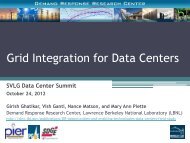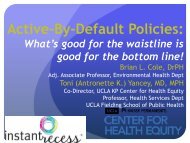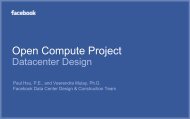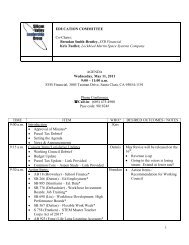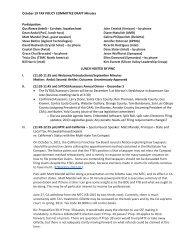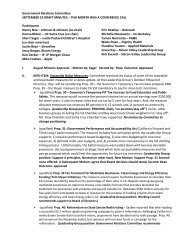2007 Silicon Valley Projections - Silicon Valley Leadership Group
2007 Silicon Valley Projections - Silicon Valley Leadership Group
2007 Silicon Valley Projections - Silicon Valley Leadership Group
You also want an ePaper? Increase the reach of your titles
YUMPU automatically turns print PDFs into web optimized ePapers that Google loves.
Education<br />
These changes in student demographics have ramifications at<br />
the end of the “pipeline.”<br />
For our Latino students, the college pipeline—and thus the<br />
workforce pipeline—is narrow. According to the Public Policy<br />
Institute of California, Latino students make up 33% of the<br />
state’s public high school graduates, but 14% of UC enrollees<br />
and 23% of CSU enrollees. Moreover, only 16% of Latino students<br />
are eligible for CSU and 7% are eligible for UC—half of<br />
their white counterparts. (Source: PPIC; Educational<br />
Resources and Outcomes by Race & Ethnicity, 2005)<br />
In <strong>Silicon</strong> <strong>Valley</strong>, the scope of the path and reliability of this<br />
“pipeline” becomes evident upon examination of the class<br />
enrollment data for ethnic groups in the region.<br />
In large part, the past decade shows increasing enrollment in<br />
college preparatory classes within each of the ethnic groups in<br />
<strong>Silicon</strong> <strong>Valley</strong> (see bar graphs). But, in the context of all of the<br />
9-12th grade students enrolled in those courses, as the courses<br />
progress, the share of Latino students enrolling declines dramatically.<br />
(Note: SVLG data analysis found this to be true in<br />
1st year chemistry and physics enrollment.)<br />
How California and <strong>Silicon</strong> <strong>Valley</strong><br />
Can Make Progress<br />
Student success in K-12 will come from a strong teacher<br />
and principal corps. The teaching profession is in constant<br />
change, and the demographics surrounding it are not promising:<br />
more teachers retiring than entering, mandates from<br />
Sacramento multiplying, and teacher salaries lagging behind<br />
the cost of living, to name a few.<br />
The state must support professional development to ensure<br />
that schools are implementing a sound, standards-based<br />
curriculum and instructional programs, and provide teachers<br />
and principals with the tools needed to instruct a diverse population<br />
in a changing world. If the state is serious about developing,<br />
recruiting and retaining teachers—particularly in<br />
math and science—then it should invest with “both feet.”<br />
The California Teach program, which is designed to recruit<br />
science and math graduates into the teaching profession,<br />
received most of its initial funding from the private sector and<br />
$1 million from the state.<br />
Investing in what matters. Achievement and advancement<br />
in math and science are the bedrock of <strong>Silicon</strong> <strong>Valley</strong>’s innovation<br />
economy. Our nation, state and region—particularly<br />
within high-need schools—are facing a critical shortage of<br />
math and science teachers. The way that the state allocates<br />
funding—in an overly complex manner and through a myriad<br />
of restrictive categorical programs—does little to allow our<br />
public K-12 and higher education systems to adapt to changing<br />
times. Moreover, market forces must enter into the equation<br />
for recruiting and retaining talent in critical fields.<br />
Hold districts to high standards and give them flexibility<br />
to meet those standards. It is common practice to give districts,<br />
in the name of local control, additional resources that<br />
are quickly followed by restrictions. The state has established<br />
a standards and accountability system. Districts should be<br />
allowed to retain flexibility in meeting those standards; districts<br />
that are successful retain flexibility and districts that are<br />
not as successful receive less. The current system does not<br />
allow innovation at the district or school level.<br />
Students need to be aware of the pathways ahead of them<br />
(workplace, college, financial aid, etc.). This is particularly<br />
important for students of immigrant families or from underrepresented<br />
populations. The fact that an entire high school<br />
might share a guidance counselor or two is unacceptable,<br />
although recent efforts by the Legislature and Governor to earmark<br />
funding for guidance counselors is a step in the right<br />
direction.<br />
Access to college needs to be available and predictable.<br />
Students and families should not have to wonder from year to<br />
year whether there will be a place for qualified applicants at<br />
state colleges and universities and what it might cost.<br />
Skills for entering the workplace and for entering college<br />
are converging. A high school diploma needs to convey that<br />
the graduate has mastered a specific set of skills; that, in large<br />
part, the student is prepared to enter college, university or<br />
the workforce; and that it is not the end of the individual’s<br />
learning. California needs to maintain high standards and<br />
expectations, and students will rise to the occasion.<br />
Make decisions based on accurate student and teacher<br />
data. As California rightfully raises academic standards, it<br />
needs a data system that will support accountability, particularly<br />
when it comes to high school graduation and proficien-<br />
21



